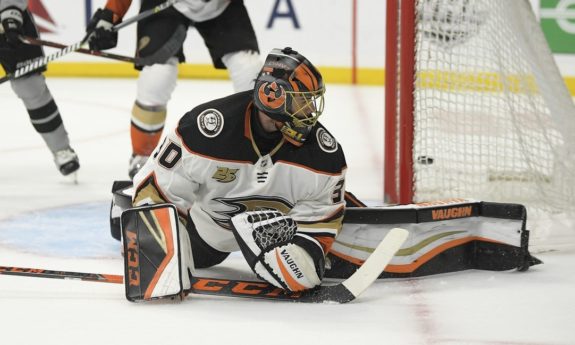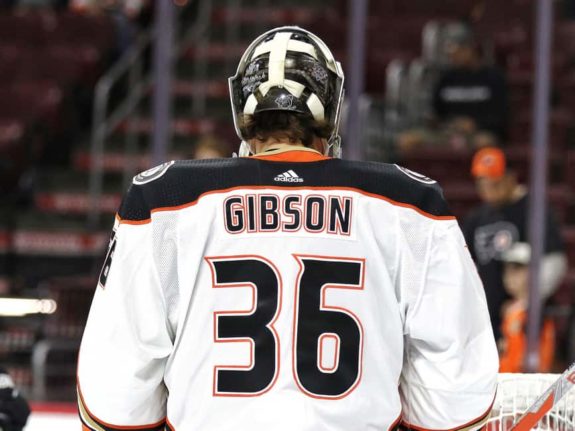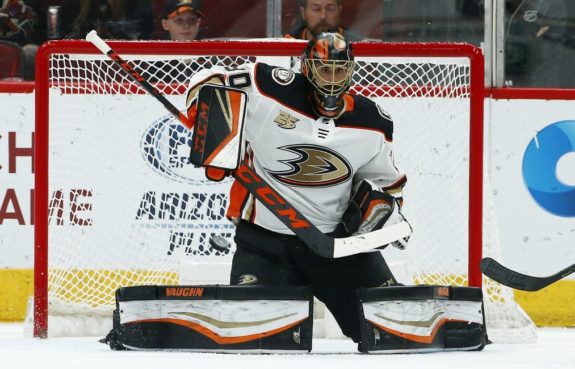The Anaheim Ducks are 2-0 following the opening week of the NHL season. After expecting a lot from the Swede line and Jakob Silfverberg, the Ducks actually benefited from the strong play of their fourth line, defensemen joining the offense and reliable, sturdy play from goaltender John Gibson. Week two of the NHL season will begin to answer another critical question for the Ducks: When will new coach Dallas Eakins utilize backup goaltender Ryan Miller? What does that mean for Gibson and the Ducks?
Ducks Have a Busy Week
After opening the season at home with two wins over the Arizona Coyotes and San Jose Sharks, the Ducks travel east to battle the Detroit Red Wings, Pittsburgh Penguins and Columbus Blue Jackets in the span of four days.
Anaheim plays the Penguins and Blue Jackets back-to-back Thursday and Friday. What does this mean? It means we should get our first glimpse of Miller for the season.

In 2018-19, Miller didn’t appear until the fifth game of the season against the Dallas Stars when former coach Randy Carlyle mercifully pulled Gibson after he faced 44 shots in only two periods. Miller didn’t actually start a game until the following matchup against the St. Louis Blues.
This season needs to be different and Eakins has the perfect opportunity to play Miller in either Pittsburgh or Columbus. One would think that Miller will play in one of those games, but if he doesn’t, that would be a bad early sign of desperation from Eakins, who might be seen as clinging to Gibson’s reliability in an attempt to attain early success with the Ducks.
Importance of a Rested Goaltender
Whether or not you think Gibson is prone to injury (it’s a touchy subject for some fans lately), the importance of having a capable backup that can take the pressure off the starter is vital for success in today’s NHL.
Last season, Carlyle relied on Gibson heavily, especially after a knee injury sidelined Miller for 24 games. Before Miller’s injury, Gibson played in 25 of 31 games. That’s 81 percent of Ducks contests. After Miller’s injury, he played in 21 of 24 games or 88 percent. Carlyle was coaching for his job, so he didn’t have very much to lose by riding one of the best young goaltenders in the league.

Still, overworking a starting goaltender throughout the regular season isn’t an effective way to win late regular-season and playoff games. National Post scribe Michael Traikos highlighted the obvious importance of a rested goalie just over a week ago.
Only two goalies (Minnesota’s Devan Dubnyk and Montreal’s Carey Price) appeared in 65 or more games last season. Both missed the playoffs, while Winnipeg’s Connor Hellebuyck, who ranked third with 63 games, failed to get out of the first round. Coincidence? Maybe. After all, it’s not as if St. Louis purposely rested Binnington for the postseason.
For the record, Binnington played a combined 48 games in the NHL and the American Hockey League last season. That would have ranked him 21st amongst NHL goalies.
(from ‘TRAIKOS: Taking the load off the starting goaliesback’ National Post – 9/26/19).
Whether Gibson is injury prone or not, it will be vital to rest him like it is for all NHL teams to rest their starters.
Miller Is Motivated
In an interview with Elliott Teaford of the Orange County Register, Miller explained why he returned to Anaheim to play his 17th NHL season.
“Last year, it was tough because our record wasn’t great, but also because of the injury I had,” Miller said after a recent practice at the Ducks’ sparkling new facility, Great Park Ice in Irvine. “I kind of felt robbed of some hockey. I didn’t want to go out with that kind of a feeling.”
(from ‘Ducks goalie Ryan Miller, 39, explains why he came back’ The Orange County Register – 10/1/19).
Teaford also points out that Miller played in his fewest number of games, 20, that he has since 2003-04. At 39 years old, Miller isn’t exactly young, but last season’s injury and an over-reliance on Gibson may be a blessing in disguise for the Ducks.

Miller is rested and motivated, and if he’s given more of an opportunity to play for Anaheim, it could do both he and Gibson some good. As a backup, Miller still has to contend with playing irregularly, a difficult task for a player who is used to be a starter.
Turning Back the Clock
Shooting for a season more like 2017-18 would be good for the Ducks and Miller. He appeared in 28 games and recorded the second-lowest goals-against average of his career at 2.35 as well as his second-highest save percentage at .928. More appearances could help Miller stay sharp throughout the season and would provide more rest for Gibson.
This week’s games will be an essential test to see how willing Eakins is to play Miller and it will show how prepared Miller is to play his 17th NHL season at 39 years old. If the Ducks trust Miller and he can regain his old form, beating the Ducks will be that much harder.
All stats from hockey-reference.com